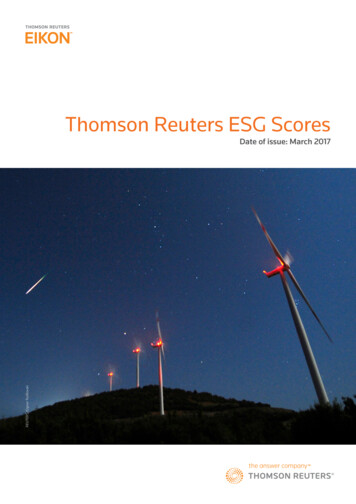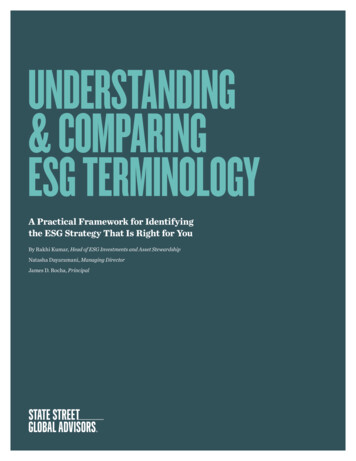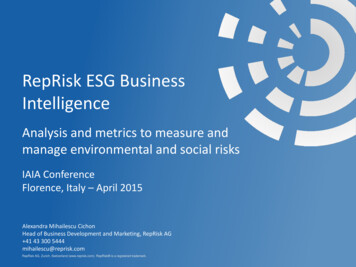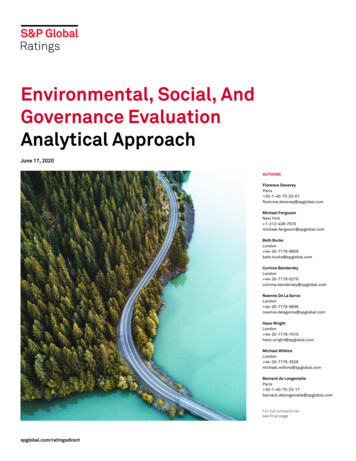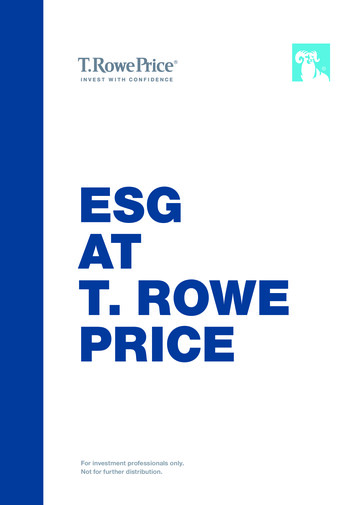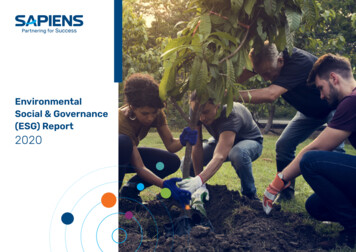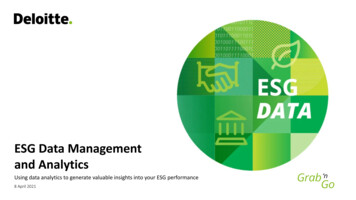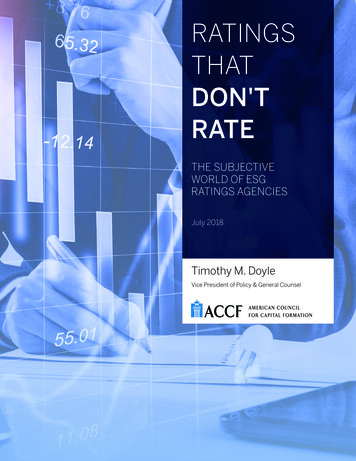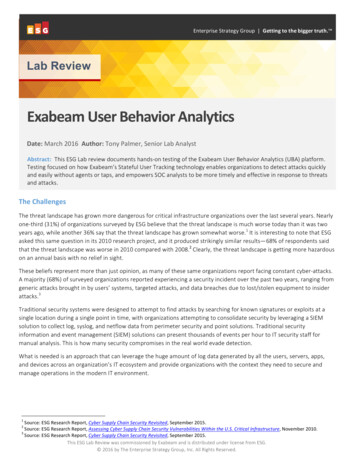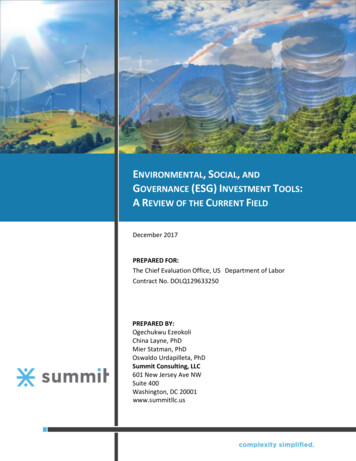
Transcription
ENVIRONMENTAL, SOCIAL, ANDGOVERNANCE (ESG) INVESTMENT TOOLS:A REVIEW OF THE CURRENT FIELDDecember 2017PREPARED FOR:The Chief Evaluation Office, US Department of LaborContract No. DOLQ129633250PREPARED BY:Ogechukwu EzeokoliChina Layne, PhDMier Statman, PhDOswaldo Urdapilleta, PhDSummit Consulting, LLC601 New Jersey Ave NWSuite 400Washington, DC 20001www.summitllc.us
ESG Investment Tools: A Review of the Current FieldDISCLAIMERThis report was prepared for the U.S. Department of Labor (DOL), Chief Evaluation Office, underContract Number DOLQ129633250. The views expressed are those of the authors and should not beattributed to DOL, nor does mention of trade names, commercial products, or organizations implyendorsement of same by the U.S. Government.i
SGTools:A Reviewof theofCurrentField FieldESGInvestmentInvestmentTools:A Reviewthe CurrentACKNOWLEDGEMENTSWe would like to thank Sonal Mahida, and Dr. David Wood for providing technical input regarding thecontent of the literature review and design of the environmental scan. We would also like to thank thestaff at the U.S. Department of Labor’s Employee Benefits Security Administration (EBSA) and the ChiefEvaluation Office who provided feedback and guidance in this study. Special thanks are due to ourContracting Officer Representatives, Janet Javar and Dr. Kuangchi Chang of the Chief Evaluation Office,who provided valuable feedback. We are also grateful for the detailed review provided by EBSA’s LynnJohnson.ii
SGTools:A Reviewof theofCurrentField FieldESGInvestmentInvestmentTools:A Reviewthe CurrentTABLE OF CONTENTSEXECUTIVE SUMMARY . IINTRODUCTION . 1ESG INVESTING AND ESG INVESTMENT TOOLS . 1IMPORTANCE OF ESG INVESTING TO RETIREMENT SECURITY . 3REVIEW OF LITERATURE ON ESG INVESTING AND RETIREMENT SAVINGS . 6RESEARCH QUESTIONS AND METHODOLOGY . 6WHO ARE THE KEY INVESTORS IN BOTH THE ESG INVESTING AND RETIREMENT SAVINGS SECTORS?. 6HOW DO KEY INVESTORS ASSESS ESG INVESTMENTS FOR GENERAL AND RETIREMENT INVESTMENT PORTFOLIOS?. 8WHAT ARE THE COMMON CHALLENGES AND CRITIQUES OF THE METHODS FOR ASSESSING ESG INVESTMENTS? . 11ESG INVESTING AND RETIREMENT SAVINGS: PRESENT STATE AND FUTURE POSSIBILITIES. 17ENVIRONMENTAL SCAN OF ESG INVESTMENT TOOLS . 18RESEARCH QUESTIONS AND METHODOLOGY . 18ASSESSMENT OF ESG INVESTMENT TOOLS BY KEY FEATURES . 21COMPARING ESG INVESTMENT TOOLS BY THEIR UTILITY . 25ESG INVESTMENT TOOLS MATRICES BY TOOL CATEGORY . 26CONCLUSION . 39REFERENCES. 41GLOSSARY BY TOPIC. 45APPENDIX A – LIST OF ESG INVESTMENT TOOLS . A-1APPENDIX B – COMPLETE PROFILES OF ESG INVESTMENT TOOLS (INCLUDED IN MATRICES). B-1APPENDIX C – SUMMARIES OF ESG RATING METHODOLOGIES . C-1iii
SGTools:A Reviewof theofCurrentField FieldESGInvestmentInvestmentTools:A Reviewthe CurrentLIST OF FIGURESFigure 1: ESG Investing Landscape . 7Figure 2: Process for Conducting Environmental Scan of ESG Investment Tools . 19Figure 3: Investments Covered by the ESG Investment Tools . 22Figure 4: Financial Information Provided by ESG Investment Tools . 24Figure 5: Fees for ESG Investment Tools. 25Figure 6: Comparison of ESG Investment Tools for Mutual Fund and ETFs . 27Figure 7: Comparison of ESG Investment Tools for Companies . 30Figure 8: Comparison of ESG Indices . 35Figure 9: Other Types of ESG Investment Tools. 38LIST OF TABLESTable 1: General Investment Strategies for ESG Investments . 8Table 2: Issues with ESG Investment Strategies . 12Table 3: Issues with ESG Investment Strategies . 20Table 4: ESG Investment Tool Utility Criteria . 21Table 5: ESG Investment Tool Categories . 21Table 6: In-Scope ESG Investment Tools (28) . 22iv
SGTools:A Reviewof theofCurrentField FieldESGInvestmentInvestmentTools:A Reviewthe Current[This Page Is Intentionally Left Blank]v
SG Investment Tools: A Review of the Current FieldEXECUTIVE SUMMARYAs investors increasingly consider environmental,social, and governance (ESG) factors when selectingand managing investments, questions about ESG’srelevance to retirement investing have growncommensurately. With this growth comes greaterinterest to understand if and to what extent ESGinvesting might affect American workers' retirementprospects. This study seeks to understand the currentstate of ESG investing, specifically how it relates toretirement savings of American workers and the toolsthat individual investors, financial advisors, investmentmanagers, and retirement plan administrators use toidentify, assess, and select ESG investments.This study, for which the Department of Labor (DOL)Chief Evaluation Office (CEO) and Employee BenefitsSecurity Administration (EBSA) contracted Summit Consulting, LLC (Summit), addresses this need byproviding: A review of the academic and industry literature regarding ESG investing and retirement savings An environmental scan of ESG investment tools available to investorsThe literature review summarizes the state of the ESG investing field and how four key investorgroups—(1) financial advisors and money managers, (2) individual investors, (3) private-sectorretirement plans, and (4) public pension plans—incorporate ESG investments into their portfolios.Across the investing sector, researchers have little consensus on the most effective ESG investmentstrategies (e.g. positive or negative screening versus ESG integration). Additionally, the literature doesnot provide much insight into how investors and advisors incorporate ESG investments into retirementsavings, especially in private-sector retirement plans.The environmental scan considers 28 ESG investment tools. ESG investment tools are online resources(specifically documents, applications, websites, or databases) that provide information on ESG aspectsof investments and/or assist users in selecting and managing ESG investments. While not intended to beexhaustive of all available ESG investing resources, these 28 tools are representative of a segment of theESG investing field, specifically the ESG research and products produced by third-party informationproviders for investors, as of May 2017. Summit grouped the 28 tools into four categories based on thetypes of investments they cover: Mutual funds and exchange-traded funds (4 tools)i
SGTools:A Reviewof theofCurrentField FieldESGInvestmentInvestmentTools:A Reviewthe Current Individual companies (16 tools) Market segments (6 tools) Other entities, e.g. investment manager strategies and retirement plans (2 tools)This research highlighted the following themes across the ESG tools on their key features andcapabilities: Most tools (20 of 28) provide a rating that describes a particular aspect of ESG performance for theunit of investment (i.e. mutual fund) and could be compared to the ESG performance of its peers(e.g. those in the same category or sector). 1 More than half of the tools (16) did not provide financial information about the investments, suchas historical financial performance, which demonstrates the need for these tools to be usedalongside tools or resources that provide traditional investment information. At least one tool inevery category provided financial information about the investments or index constituents.However, most tools in the individual company category did not provide any financial information. All tools are available online, but many (23) have user costs that limit their accessibility to someusers. 2 Most of the ESG tools that cover mutual funds, exchange-traded funds, or market segmentsprovide some ESG information at no cost, while most tools for individual companies have user fees.Beyond familiarizing investors, advisors, and regulators with the current state of ESG investing, thisstudy serves as a digest of the ESG investing sector upon which DOL can expand in future years as theESG investing landscape continues to grow and mature.Features of ESG Tools Most ESG tools are performance ratings or provide performance ratings. ESG information needs to be used alongside traditional financial metrics ofinvestments. Many tools have user fees and may not be accessible for all investor groups.1Twenty tools provide ESG ratings and six tools use pre-determined ESG ratings (all tools use ESG ratings to determine theconstituents of ESG-focused indices).2 Some of the fee-based tools covered in this report may cost anywhere from 450 to 200,000. The providers of some fee-basedtools declined to provide cost information due to the sensitivity of such information.ii
SGTools:A Reviewof theofCurrentField FieldESGInvestmentInvestmentTools:A Reviewthe CurrentINTRODUCTIONESG INVESTING AND ESG INVESTMENT TOOLSIn addition to strong financial returns, investors may want to know that the companies receiving theirdollars are promoting socially conscious policies, activities, and relationships. Environmental, social, andgovernance (ESG) investing provides criteria that allow investors and advisors to select investments thatalign with their values as well as their financial goals. 3Examples of issues that investors considerinclude: Environmental—climate change,emissions, air and water pollutionESG Investing incorporatesenvironmental, social, and governanceissues into the selection andmanagement of investments.carbon Social—gender and diversity policies, humanrights,laborstandards,employeeengagementESG Investing is often usedsynonymously with other investingterms such as: Sustainable Investing (SI) Governance—executivecompensation,board composition, bribery and corruptionpolicies 4 Responsible Investing (RI) Socially Responsible Investing (SRI)Other types of investing terms that are often usedsynonymously with ESG investing include 5: Sustainable Investing (SI)—the full integration of ESG factors into financial analysis and decisionmaking (Keefe, 2007) 6,7 Responsible Investing (RI)—an approach that aims to incorporate ESG factorsinto investment decisions to better manage risk and generate sustainable, long-term returns 8 Socially responsible investing (SRI)—an investment approach that aims to simultaneously achieveenvironmental and social goals, as well as financial goals 93DB Climate Change Advisors, “Sustainable Investing: Establishing Long-Term Value and Performance,” 2012,https://institutional.deutscheam.com/content/ media/Sustainable Investing 2012.pdf.4 Morningstar’s 7 Myths and Facts about Sustainable Investing5 The related idea of corporate social responsibility (CSR) refers to the act of businesses considering and managing the economic,environmental, social, and governance impacts of their operations. Mercer, “The language of responsible investment: An industryguide to key terms and organisations”, 2007, http://www.belsif.be/user docs/MercerInvestmentConsultingSRI.pdf.6 Mercer “The language of responsible investment: An industry guide to key terms and organisations,” 2007,http://www.belsif.be/user docs/MercerInvestmentConsultingSRI.pdf.7 According to DB Climate Change Advisors, best-in-class approach is an investment approach that focuses on companies thatperform better than their peers in a particular industry or category do.8 vestment.1
SGTools:A Reviewof theofCurrentField FieldESGInvestmentInvestmentTools:A Reviewthe CurrentWhile ESG, SI, RI, and SRI investing are each unique terms, they refer to the same idea of including nonfinancial factors alongside financial factors when choosing and managing investments. This report usesthese terms under the umbrella term ESG, following the convention of academic and professionalliterature.Interest and participation in ESG investing has increased notably in recent years. Bloomberg reportedthat the number of terminal clients who access ESG data for their analysis grew from 3,010 in 2010 to12,242 in 2016. 10 Clients accessing ESG data for analysis represented about 3.7% of the 325,000 globalsubscribers. 11 In addition, total U.S.-domiciled assets under management (AUM) invested in ESG optionsgrew from 6.57 trillion in 2014 to 8.72 trillion in 2016, a 33% increase (or an 18% increase afteraccounting for general market growth). 12,13 This growth is driven by investor demand for ESGinvestments. Because of this growth, ESG investments now form a significant share of total U.S.domiciled AUM (22%). 14The growth in ESG investing has strengthened the investing environment, and companies areincreasingly reporting their ESG practices. In 2015, 81% of S&P 500 companies issued reports on theircorporate social responsibility, a significant increase from 20% of S&P 500 companies in 2011. 15 Inaddition, aggregating data sources, such as indices designed for researching ESG investments, aregrowing significantly. Leading industry firms, such as MSCI and Thomson Reuters (Snider, 2016), havereleased ESG indices, as well as the Dow Jones Sustainability Indices (Tool 24) and FTSE4Good Indices(Tool 23) (Billiteri, 2008).With the growth of ESG investing, the financial services industry has developed a slate of tools to guideand educate investors. These tools help users identify, assess, or select ESG investments when buildinginvestment portfolios, as well as manage existing ESG portfolios. By design, the tools accommodate avariety of users, including individual and institutional investors, money managers, and financial advisors.Primarily offered as online products (websites, documents, databases, interactive applications), thesetools are accessible to a broad community.ESG tools include online applications, websites, databases, and documents that helpinvestors and advisors identify, assess, or select ESG investments.Using these tools, investors can explore various investment options such as individual company stocks,mutual funds, and exchange-traded funds to identify those that align with the investor’s preferred ESGfactors (i.e. environmental, social, or governance). The output of these ESG tools is an evaluation of theESG orientation of specific investments, either conventional or ESG-identified investments, or the ESGorientation of a broad investment market segment, such as the domestic large-cap equities market. The9Ibid.Bloomberg, “Customers Using ESG Data,” https://www.bloomberg.com/bcause/product/.11 https://www.bloomberg.com/company/12 “Assets under management” is defined by US SIF to include investment assets managed by institutional investors, moneymanagers, and community investment institutions.13 US SIF, “Report on US Sustainable, Responsible, and Impact Investing Trends,” 2016,http://www.ussif.org/files/SIF Trends 16 Executive Summary.pdf.14 Ibid.15 Governance and Accountability Institute, Inc., Flash Report: .102
SGTools:A Reviewof theofCurrentField FieldESGInvestmentInvestmentTools:A Reviewthe CurrentESG information produced by these tools can be used to select investments, manage portfolios, createinvestment products (such as mutual funds that track ESG indices), and benchmark performance.As discussed in the methodology section, our report categorizes ESG tools in four groups based on thetypes of invested entities or investment vehicles they cover: (1) mutual funds and exchange-tradedfunds, (2) companies, (3) market segments, and (4) other entities.As noted by SustainAbility (2010) and Novethic (2013) in their review of ESG rating agencies, the sectorcontinues to undergo rapid evolution. Both reports discuss the substantial changes in the field since2000, including an increase in tools and services, a broadening of the scope of ESG tools, and aconsolidation of the field of tool providers. SustainAbility observed that ESG tool providers frequentlyuse ESG ratings and tools to develop additional products and services. 16 These ESG tools often begetadditional ratings and tools from other ESG tool providers. Novethic discussed the increased scope ofESG tools to focus on international markets and rate other types of investments (beyond companystocks and mutual funds), such as government debt. Finally, both reports document the continuedconsolidation of the field, with some ESG tool providers going out of business or being acquired by otherproviders.IMPORTANCE OF ESG INVESTING TO RETIREMENT SECURITYESG investing is a growing segment of America’s retirement investing landscape. Public pension fundsand private retirement plans (7% of corporate defined benefit plans and 24% of corporate definedcontribution plans) now include ESG investments in their portfolios. 17 Key groups in the retirementinvesting field (e.g. individual investors, financial advisors, investment managers, and retirement planadministrators) use ESG investment tools.The rapid change in the ESG sector and its potential to affect the retirement prospects of Americanworkers raises the need for greater insight into the ESG investing sector. In order to safeguard workers’retirement security, DOL and other policymakers need comprehensive information on the tools used inmaking ESG investment decisions and a better understanding of the relevance of ESG investing toretirement savings. In June 2016, DOL’s Chief Evaluation Office (CEO), in conjunction with the EmployeeBenefits Security Administration (EBSA), contracted with Summit Consulting, LLC (Summit) to conduct astudy that covers two topics: The academic and industry literature related to how investors and advisors integrate ESGinvestments into retirement savings (literature review) Current investment tools that focus on ESG investments (environmental scan)The primary goal of this study is to inform DOL, investors, and advisors on ESG investing as it relates toretirement savings. The report begins with an overview of the academic and industry literature on thecurrent state of ESG investing, investment strategies for ESG investments, and primary critiques ofintegrating ESG investments into retirement savings. This review provides a digest of the ESG investingsector that can expand in future years as the ESG investing landscape continues to grow, diversify, andmature. The environmental scan provides an overview of current ESG tools, detailing information oneach tool’s characteristics and features and an assessment of the relative utility to different user groups.16This is observed in our environmental scan, the second part of the study.Pensions & Investments, “After a bit of help, ESG ready to make even greater gains,” even-greater-gains.173
SGTools:A Reviewof theofCurrentField FieldESGInvestmentInvestmentTools:A Reviewthe CurrentThe environmental scan does not endorse or recommend any specific tool or tool provider. Additionally,the study focuses on the nature of the ESG investments in public equities (though some tools do provideinformation on private companies). 1818This study focused on ESG investment in public equities because private equities are generally not available to individualinvestors, unless they are high net-worth individual investors.4
SGTools:A Reviewof theofCurrentField FieldESGInvestmentInvestmentTools:A Reviewthe Current[This Page Is Intentionally Left Blank]5
SGTools:A Reviewof theofCurrentField FieldESGInvestmentInvestmentTools:A Reviewthe CurrentREVIEW OF LITERATURE ON ESG INVESTING AND RETIREMENT SAVINGSRESEARCH QUESTIONS AND METHODOLOGYTo review academic and industry literature on ESG investing and retirement savings, Summit focused onliterature relevant to the following three research questions: Who are the key investors in both the ESG investing and retirement saving sectors? How do the key investors assess ESG investments for general and retirement investmentportfolios? What are the common challenges and critiques of the current methods of assessing ESGinvestments?The study included peer-reviewed journal articles, working papers, research briefs, and technicalresearch reports, as well as industry articles, research reports, marketing content, and regulatoryguidance. The literature review focused on publications specific to the U.S. investing sector from the last15 years. We generally used the most recent published findings on a topic but also referenced olderfoundational research, e.g. studies cited numerous times up through the last year. Initially, the teamsearched the literature with known sources of information and academic researchers on the followingtopics: ESG investing and public pensions/retirement investing/fiduciary standard ESG investing and investment strategies ESG investing and performanceUsing references, citations, and related articles from these initial sources, the team expanded theliterature search to uncover the most prominent and relevant information sources.WHO ARE THE KEY INVESTORS IN BOTH THE ESG INVESTING AND RETIREMENT SAVINGS SECTORS?As shown in Figure 1, key ESG investors 19 in the retirement savings sector include money managers andfinancial advisors, individual investors, private-sector retirement plans, 20 and public pension plans. ESGinvesting has expanded to include all key investors in the sector. The following sections describe the keyinvestors and show ESG investing growth in each group.1. Money Managers and Financial Advisors19We defined key investors according to the scope of this study.private-sector retirement plans include defined benefit and defined contribution plans sponsored by private-sector companies.This group also includes multiemployer or “Taft-Hartley” plans.206
SGTools:A Reviewof theofCurrentField FieldESGInvestmentInvestmentTools:A Reviewthe CurrentMoney managers and financial advisors includebusinesses or banks responsible for managing thesecurities portfolios of individual or institutionalinvestors. The number of investment funds run bymoney managers that incorporate ESG factors grewby 12% (from 894 to 1,002 funds) from 2014 to2016 (US SIF, 2016). In the same period, the totalamount of ESG investment assets managed bymoney managers and community investmentinstitutions grew 69% (from 4.80 billion to 8.1billion) (US SIF, 2016).2. Individual InvestorsIndividual investors buy and sell securities for theirpersonal accounts, not for another entity ororganization. In 2012, 66% of 401(k) investors saidthey would like to see their employer offer ESGoptions. 21 Additionally, in 2016, 11% of high networth investors owned ESG investments. 22,23Figure 1: ESG Investing LandscapeESG investing has grown not only in the general investing sector, but also in the retirement savingssector. As outlined in a recent US SIF report, ESG investments held by institutional investors (includingpublic pension, labor union pension, and corporate retirement funds) grew 17% from 2014 to 2016. 24Next, we discuss two key investor groups relative to ESG investing and retirement savings.3. Private-Sector Retirement PlansPrivate-sector retirement plans are tax-preferred financial arrangements designed to replaceemployment income upon retirement. In 2011, a survey of defined contribution plans showed that 14%of these plans included ESG investments. 25 In 2015, 7% of corporate defined benefit plans and 24% ofcorporate defined contribution plans included ESG investments. 26 By 2016, 30% of all corporate plans(defined benefit and contribution) included ESG investments. 27 This demonstrates the growing21Pensions & Investments, “After a bit of help, ESG ready to make even greater gains”, even-greater-gains.22 In this study, high-net-worth and ultra-high-net-worth individuals were those who had at least 3 million in investable assets.23 US Trust, “2016 US Trust Insights on Wealth and Worth Survey,” ation/pdf/GWMOL/USTp AR9R6RKS 2016-05.pdf.24 US SIF, “Report on US Sustainable, Responsible, and Impact Investing Trends,” 2016,http://www.ussif.org/files/SIF Trends 16 Executive Summary.pdf.25 This survey included private-sector (for-profit and non-profit) and public sector defined contribution plans, however 60% of thesurveys were to for-profit, private-sector plans. Mercer and US SIF, "Opportunities for Sustainable and Responsible Investing inUS Defined Contribution Plans", 2011: http://www.ussif.org/blog home.asp?display 18.26 Pensions & Investments, “After a bit of help, ESG ready to make even greater gains,” even-greater-gains.27 Callan Institute, “2016 ESG Interest and Implementation Survey”, 2016, allanESGSurvey2016.pdf.7
SGTools:A Reviewof theofCurrentField FieldESGInvestmentInvestmentTools:A Reviewthe Currentimportance of ESG investments in private retirement plans. Additionally, in 2014, corporate institutionalinvestors, including private retirement plans, held 758 billion in ESG investments. 284. Public Pension PlansPublic pension plans, retirement plans offered through government employers, calculate employeeretirement benefits based on factors such as length of employment and salary history. Public pensionfunds own or manage 2.74 of 4.72 trillion of ESG assets managed by institutional investors (US SIF,2016). Additionally, in 2014, 70 of the world’s largest pension funds, including those in New York andCalifornia, engaged directly with companies to address climate change issues (Farmer, 2014).HOW DO KEY INVESTORS ASSESS ESG INVESTMENTS FOR GENERAL AND RETIREMENTINVESTMENT PORTFOLIOS?Table 1 describes seven methods for assessing ESG investments for inclusion in an investment portfolio.This section discusses commonly used investment strategies, by both general and retirement investors,as well as how investors employ ESG tools in their investment strategies.Table 1: General Investment Strategies for ESG Investments 29Type of InvestmentStrategy1. Positive screening/best-in-classDescription of Strategy/MethodSelect investments for positive performance on ESGfactors relative to industry peers (also involves avoidinginvestments that do not meet the ESG performancethresholds)2. Negative/exclusionary Exclude investments connected to activities or industriesscreeningdeemed controversial or unacceptable3. ESG integrationInclude ESG risks and opportunities in financial analysisof potential investments4. Impact investingSelect investments to generate positive social andenvironmental impact along with financial returns,regardless of whether the returns are below market5. SustainabilitySelect assets related to sustainabilitythematic6. Index basedConstruct a portfolio of investments to matchestablished indices of environmentally and sociallyresponsible companies, such as the Dow JonesSustainability Index (Richardson, 2007)7. Direct corporateWork directly with corporations to promote adoption ofengagement andESG practices (may be used in combination with otheractivismESG investment strategies [Richardson, 2007])ExamplesSocial(k) Faith Basedmutual fundSocial(k) Fossil Free mutualfundPax Global EnvironmentalMarkets FundW.K. Kellogg Fo
Interest and participation in ESG investing has increased notably in recent years. Bloomberg reported that the number of terminal clients who access ESG data for their analysis grew from 3,010 in 2010 to 12,242 in 2016. 10. subscribers. 11. In addition, total U.S.-domiciled assets under management (AUM) invested in ESG options
